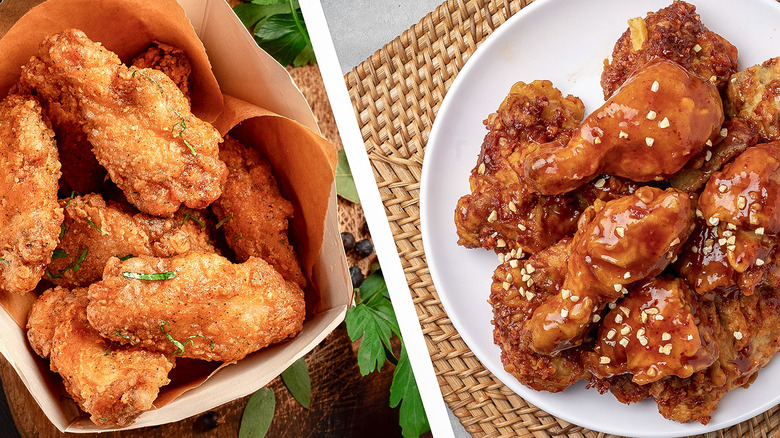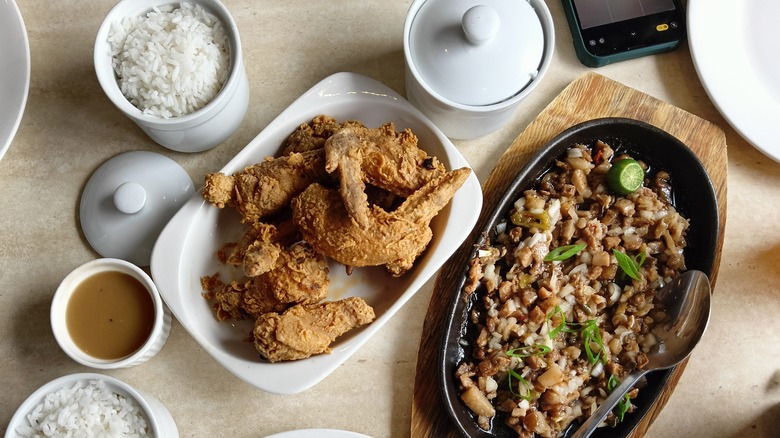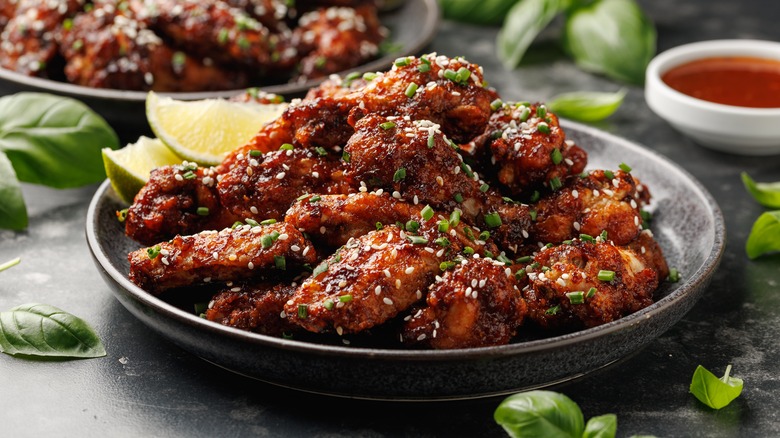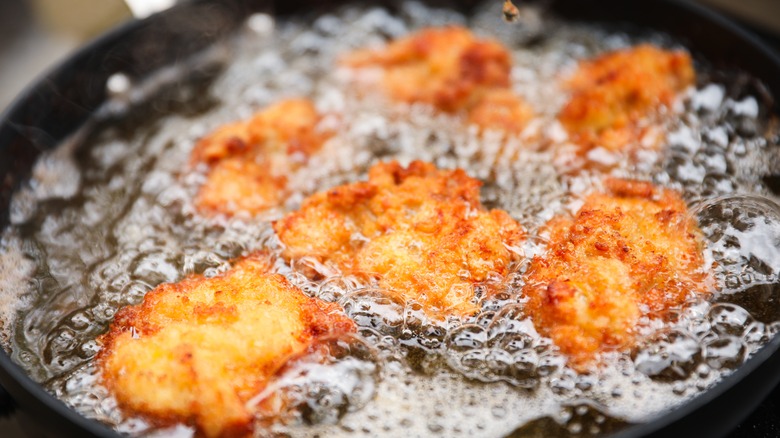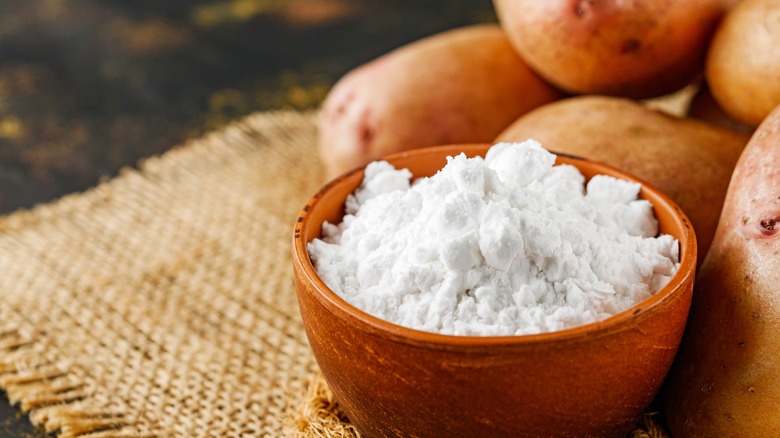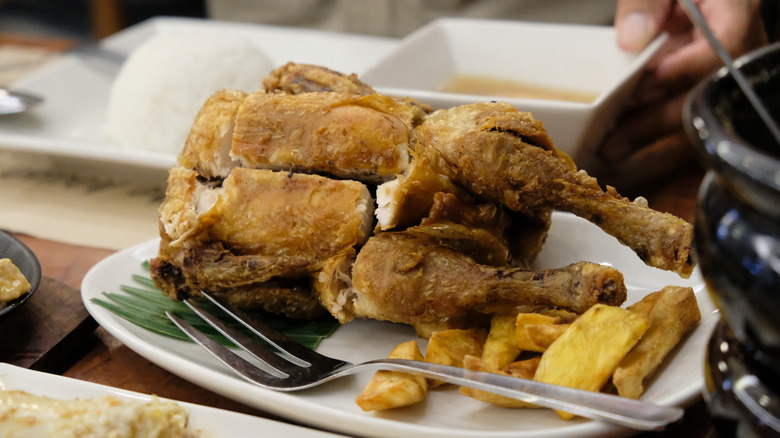Filipino Vs Korean Fried Chicken: What's The Difference?
One of the best food trends of the past few decades has been the expansion of different international styles of fried chicken into the United States. Two of these styles, Filipino and Korean fried chicken, are really emblematic of that trend. For years, if you wanted to grab some fried chicken in the U.S. you were probably getting some variation of the classic Southern-style buttermilk fried chicken, with its crackly, craggy, seasoned flour coating. But as international cuisine has expanded its footprint in America, the country slowly discovered that for as delicious as the Southern-style is, there is more than one way to make amazing fried chicken. We got juicy dark meat chicken karaage and popable Taiwanese fried chicken, but Filipino and Korean fried chicken have probably made the most headway, especially through some popular chains.
Not only are Filipino and Korean fried chicken some of the biggest international styles, they're as different from each other as they are from the various American styles. While both utilize full pieces of chicken as opposed to the smaller chopped styles like karaage, the recipes, textures, and flavors can vary greatly between the two. Filipino-style fried chicken is probably closer to the Southern-styles you already know with marinated chicken and breading, while Korean style's thinner crust and saucy finish exists in a world all its own. But the one thing they both will always have in common is how they show off the amazing flavors and creativity that comes from recipes spreading all over the globe.
What is Filipino fried chicken?
Filipino fried chicken took off in popularity post World War II after local restaurants started serving it to American G.I.s who were stationed there, and thus bears some clear similarities to American fried chicken. It is dredged in a mixture of flour and simple spices after being marinated, although breaded Filipino versions also usually involve some cornstarch for extra crunch. The marinade can be very basic as well, with just basic salt and pepper, but different chains and restaurants often use their own blends that can involve Asian flavors like soy sauce, fish sauce, and local Filipino ingredients like the citrus favorite calamansi. The real thing that sets it apart from the American style are the condiments that it's served with, with Filipino fried chicken being accompanied by soy sauce brown gravy, or another local favorite, banana ketchup.
The subtle variations in Filipino fried chicken can be seen in the two biggest fried chicken chains that have popularized the style: Max's and Jollibee. Max's traces back to Maximo Gimenez, who is credited with first serving fried chicken to American soldiers that he had befriended. The chain now has several hundred locations in the Philippines and North America. Max's chicken is steamed with aromatics before being fried without a dredge for a thin, crispy crust and served with Worcestershire sauce. Jollibee is perhaps the most famous Filipino fried chicken with 1300 plus stores worldwide. This chain's chicken is fried with a spicy Southern-style batter and served with brown gravy.
What is Korean fried chicken?
Fried chicken is one of the most popular dishes in Korea, with at least 50,000 restaurants and delivery services in the relatively small country. Like in the Philippines, the popularity of fried chicken can be traced to cultural interaction with the U.S. — American soldiers stationed in Korea during and after the Korean war first introduced the classic batter-fried style. Yet, it didn't fully take hold until the 1980s and '90s, when KFC was first opened around the time of the Seoul Olympics, and rising financial fortunes made frying oil and chicken more affordable to the average South Korean. The industry came into its own after the Asian financial crisis in the late '90s, when many struggling workers turned to opening local chicken shops to make money.
The modern Korean version of fried chicken has become its own art, and with how popular it is, there are plenty of different twists on it. The first thing that distinguishes it from American-style is how thin the coating is. Korean chicken batter is usually made with potato starch, which creates an incredibly crisp crust that stands up to different saucy coatings, although different recipes may also mix in some additional combination of roasted soybean flour for flavor, all-purpose flour, and baking soda. The second thing that is special about Korean fried chicken are the many different styles of sauces that coat the chicken, with a sweet-and-spicy gochujang-based version being the most iconic.
Both Korean and Filipino fried chicken are double fried
While Filipino and Korean fried chicken can taste quite different, they do share one big technique in how they are prepared: both are usually double fried. Along with using different types of starches in the batter, this is part of what makes so many Asian-fried chicken styles extra crispy. Double frying is exactly what it sounds like. The battered chicken is given a quick first fry in hot oil, taken out to cool, and then fried again before serving.
This method works for two big reasons. The first is how the chicken inside cooks compared to the batter. Just like searing a steak, the time it takes to cook the chicken to a nice golden brown is often too long and ends up overcooking and drying out the meat. By partially frying first and then letting the chicken rest, the inside can cool down, buying you more time on the second fry to fully crisp the exterior as the meat heats back up. As a bonus you can even partially fry chicken ahead of time and then refry it the next day, giving you more flexibility in prep.
The other big advantage is that the first fry renders fat from the skin, which helps dry it out so it gets extra-crispy on the second fry. A variation on this technique that is sometimes seen in Korean and Filipino fried chicken involves steaming or boiling the chicken before frying, which accomplishes the same result.
Korean fried chicken uses a potato starch coating
The other key to Korean fried chicken's amazing crunch is the starch used. The go-to is potato starch, which is also used in other Asian-style fried chicken like Japanese karaage. The big advantages to using starches other than flour is the lack of gluten. Because of the gluten bonds, wheat flour tends to produce a coating that is more dense when fried. Potato starch and corn starch, however, inhibit the formation of gluten, which makes them great both on their own and when mixed in with flour dredges. They also don't absorb as much oil when cooked, which prevents soggy chicken. Potato starch's big advantage over cornstarch is that the granules are larger, which makes for an even better texture and crunch when fried. The other unique starch you may see on Korean fried chicken is roasted soybean powder, which is mixed in with the potato starch. While not standard, it adds a nutty flavor and helps the chicken brown.
Filipino fried chicken tends to either be closer to an American recipe with the coating or is otherwise not coated at all. At Max's, the chicken is steamed to render the fat, then fried without any batter at all, creating a thin, crispy skin. If it's dredged with flour, then it is likely to include cornstarch as well to help up the crunch factor.
Filipino fried chicken isn't normally sauced
No matter the batter, most Filipino fried chicken is served dry, with sauces and condiments on the side, much like Southern-style fried chicken. There are a few classic sides you'll find depending on where you get your chicken. Max's serves it with Worcestershire sauce, but the more common options are gravy, which is what you'll find at Jollibee, and the popular banana ketchup, which is similar to tomato ketchup but with a sweeter fruit flavor from the banana base.
Korean fried chicken can also be served dry, but the sauces are often the star. There is yangnyeom, which is the mix of gochujang, tangy vinegar, and sweeteners like ketchup that has become a signature Korean flavor combo. Other common options include a more savory soy sauce and garlic mixture and often a sweeter honey flavor as well. Padak chicken is a unique option that tops the chicken with a mound of thinly sliced scallions and a garlic soy and mustard sauce. And of course, many local restaurants will also serve their own special recipes and house-made sauces to help stand out from the crowded scene. But no matter whether you prefer the many sauces of Korean fried chicken, or the unique condiments of the Filipino style, both show the amazing diversity of flavors that can come about as cultures put their own spin on classic dishes.
